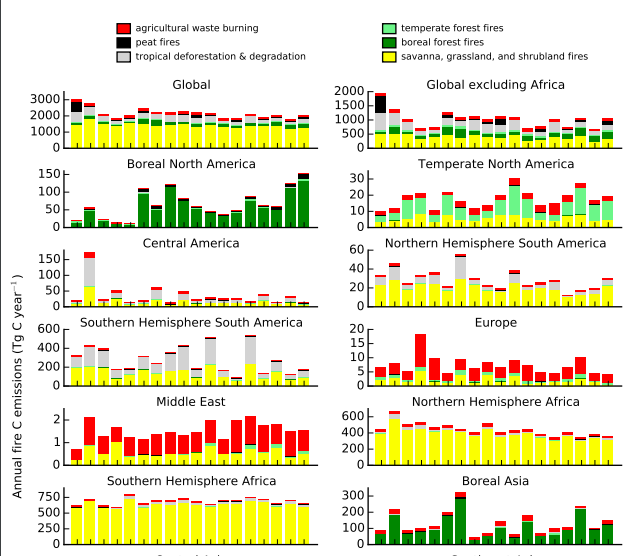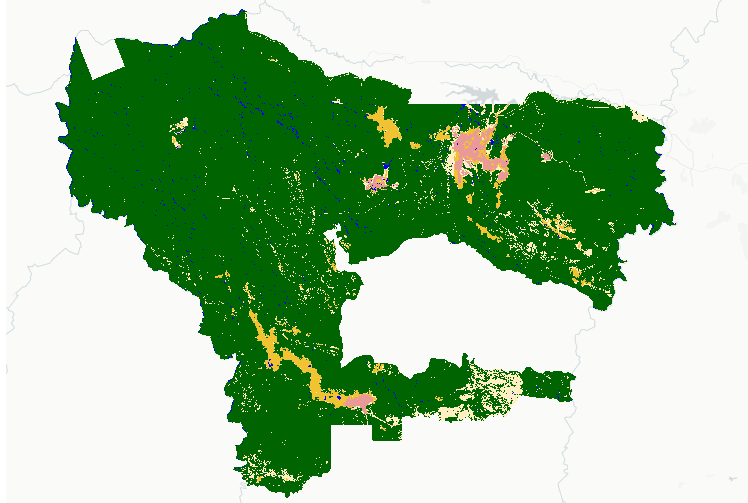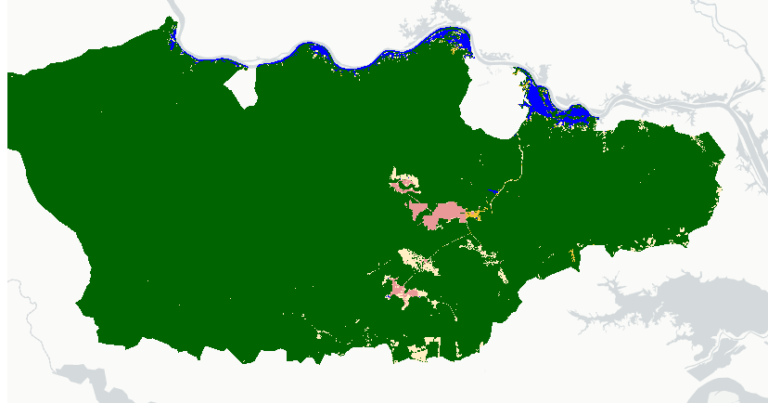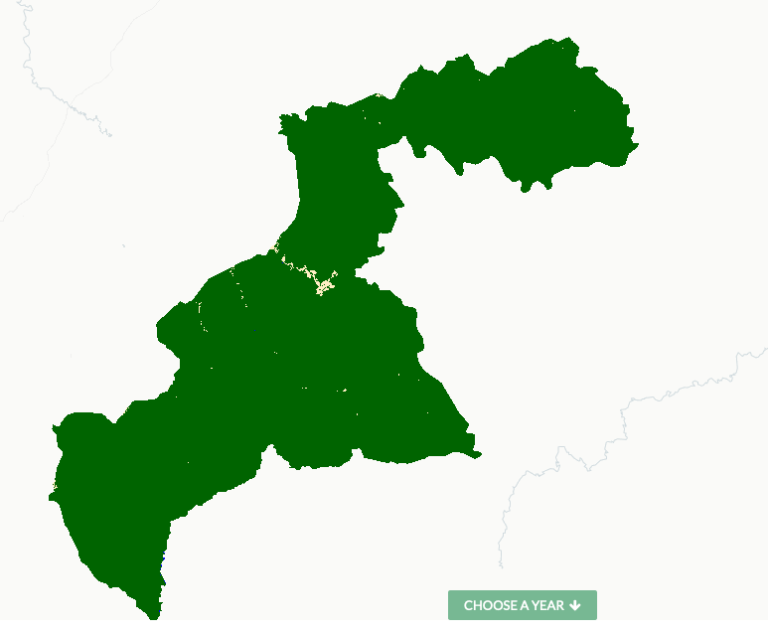This week, environment Minister Ricardo Salles and President Jair Bolsonaro insisted on the narrative that the problem of burning practices in Brazil is actually a fabrication of NGOs and foreign leaders interested in undermining the competitiveness of Brazilian agribusiness.
On Wednesday (22), Salles gave an interview to allied journalists at Jovem Pan showing the cause celèbre of the week, according to the government’s narrative: a global map published by NASA that shows Africa “burning more” than the Amazon. The next day, in one of his live streams on Facebook, Jair Bolsonaro showed the same map.
Salles claimed that Africa has more fires than Brazil, but that they do not “reverberate” as much because the region is “protected” by “European interests”. In addition to the prejudice it demonstrates, the statement is distorted: Africa, especially the Congo basin, has many fires in the dry season – often more than the Amazon – due to the type of vegetation, which is made up of open savannas and fields. There are fewer fires in forest areas. In the Amazon, the variation in the number of fires is linked to the deforestation of tropical forests. Experts insist that the two realities should not be compared.
The minister presented a series of other false or distorted information in the interview: he said that the burning rates are falling – when they increased in June and are increasing in July -, that the press did not echo Australia’s fires with the same intensity and that Carajás National Forest, in Pará, where Vale pursues iron ore mining activities, is the “better preserved forest in Pará”.
We have verified the main allegations made by the minister below.
“This year, due to the performance of GLO and the decree signed by President Bolsonaro, we are already seeing reductions in the rates of burning. It is an important task that requires the joint efforts not only of the federal government, but also of the states.”
FALSE
The decree authorizing the operation of the Army (GLO) was signed on May 11. In June, the first month to be fully evaluated after the GLO was in force, there was an increase of 19.6% in the heat sources in the Amazon biome in relation to the same month of the previous year, according to INPE. The total of 2,248 outbreaks was the highest for the month in the past 12 years. By July 23, the increase was 27% compared to the same period last year.
Even if we consider the entire first semester, the total number of hot spots in the biome in 2020 (7,903) was higher than in eight of the last ten years (only the first semesters of 2016 and 2019 registered more hot spots).
“First, Africa does not have the amount of NGOs and pseudo specialists that exist here in Brazil, so there are not so many people to make noise about this issue. Second, Africa is not a competitor in the agribusiness arena like Brazil, a country that produces quality products at competitive prices and on a large scale (…) This region of Africa, which in general is protected by many interests, including those of Europe, does not have a president against the establishment like president Bolsonaro. So there is really a very clear explanation as to the excessive reverberation over fires in Brazil, totally ignoring what is happening in Africa. In fact, last year was no different. If we look at what was said about fires in Brazil, soon afterwards Australia had a substantially higher volume of fires . And there was nowhere near the same coverage by the international press and some foreign political leaders as we faced here in Brazil.”
FALLACIOUS
News articles or political statements concerning burning practices in Africa, Australia or any other country do not remove the problem of fires in Brazil, which are increasing and lead to serious consequences for the environment and for the population. Such argument was repeated by President Jair Bolsonaro in a live stream yesterday (July23) to try to ward off reality: official data show that deforestation in the Amazon is increasing uncontrollably while IBAMA agents have been removed from command positions in the Amazon.
In addition, the comparison mentioned by Salles and Bolsonaro does not make sense, as the situations are different. In relation to sub-Saharan Africa, for example, the area burned annually in general is larger than that of the Amazon in terms of extension. This is due to the agricultural practices of the region and the vegetation, which is very different from the Amazon – savannas and fields , instead of a tropical forest that is systematically destroyed. The NASA chart shows the difference between the type of burning emissions in sub-Saharan Africa (SSHA) and South America.

Australia had between the second half of last year and the beginning of this year the worst burning season in its history, caused by a heat wave – whose severity is attributed to climate change -, not by land use. Regarding the coverage of the international press, the minister makes a false statement. A simple search on the Reuters agency for “Amazon fires 2019” and “Australia fires 2019” shows 179 news about the Amazon and 360 news about Australia. The explanation is simple: Australian fires have hit densely populated areas and, for the Anglo-Saxon and European press, Australia is much easier to cover than the Amazon.
“When we carry out inspection actions, we do not know who is being monitored, who is occupying that territory. (…) Land regularization is a fundamental prerequisite for the territorial organization of the Amazon and the responsibility of parties, especially in relation to the application of the Forest Code. If there is no owner, we have no one to does not take to the face the enforcement of the rules of the Forest Code.”
FALSE
In the Amazon, most deforestation occurs in private areas, where it is possible to know in advance who owns the land. Even so, enforcement (inspection and punishment) is not accomplished . An analysis carried out by MapBiomas of all deforestation alerts recorded by INPE in 2019 showed that two-thirds of deforestation in Brazil occurred in areas that crossed at least one Environmental Rural Registry (CAR) – i.e., it is possible to know who owns the area and punish that person. Based on this, IBAMA created in 2016 Operation Remote Control, to monitor deforestation without the need to go to the field in each and every case. Likewise, deforestation was reduced by more than 80% between 2004 and 2012 without the need to change land ownership laws.
“Rates of deforestation in 2004 and 2005 were three times higher than last year. Therefore, it is not true that deforestation last year set a record rate for the Amazon. It is practically a third of what it was in 2004/2005. Even so, we consider that this increase, which dates back to from 2012, is a consequence of an absence of public policy in the region.”
FALLACIOUS
Salles resorts to the argumentative fallacy known as “scarecrow”, by which a false premise is raised (“deforestation in 2019 set a record rate in the Amazon”) to be countered with real data (deforestation in 2004 affected almost 28 thousand km2, therefore, it was almost three times greater than the 10,000 km2 of 2019).
The increase in deforestation from 2018 to 2019, the first year of Bolsonaro administration, was the second highest since 1988, when the systematic monitoring carried out by INPE began, registering an increase of 34.4% over the previous year. This is only lower than the increase that took place from 1994 to 1995, which was 95.1%. The 2019 rate was a record for the past 24 years and only reinforces the tendency of lack of control of deforestation in the Amazon, which is expected to further increase in 2020. In absolute terms, the measured rate (10,129 km2) was the highest since 2008.
“Thanks to the GLO operation, which fought fires in September and October, the Bolsonaro administration brought the rate of fires in that period to the lowest level in the last 20 years.”
EXAGGERATED
The official number of hot spots in the Amazon biome, which had exploded in August 2019, fell in September and October. But in September, the lowest rate in the last 20 years was not registered: there were 19,925 outbreaks, but in 2013, 16,786 had been registered. The total number of hot spots for October 2019 was the lowest since 1998, the beginning of the historical series, but there is no way to attest, as stated by the minister, that the cause was the participation of the Armed Forces in the firefighting operations.
“And this year, on May 11, when GLO starts, we saw last month on the INPE website that fires were reduced by 23%.”
FALSE
There was a 19.6% increase in the number of hot spots in the Amazon biome in June, the first full month in which GLO was in force, compared to the same month of the previous year, according to INPE . The total of 2,248 outbreaks was the highest for the month since 2008. Even if another criterion is considered, not by biome, but by states in the Legal Amazon (which includes stretches of “cerrado” and other areas), the total outbreaks remained stable at 4,838 in June 2019 and 4,596 in June 2020, a reduction of 5%.
“Brazil has one of the most restrictive laws in the world, I would venture to say perhaps that it is the most restrictive in the world, namely the Forest Code. Many countries that criticize us have nothing even close, or similar to what we have.”
FALSE
There are at least 11 countries that have strict forestry laws. According to a comparative study carried out in Brazil, in 2011, by Imazon and ProForest, the United Kingdom and India are two examples of countries where the legal reserve – understood as the portion of forests under private property – is even more rigorous than in Brazil. While landowners here can deforest 80% of their property in most biomes (except in the Amazon, where the limit is 65% for “cerrado” areas and 20% for forest areas), Indians and British are totally prohibited from deforesting in their forest areas. In Japan, where 59% of the forests are under private property, the law also prohibits deforestation entirely. In France, the conversion of more than 4 hectares is totally prohibited. In Germany and the Scandinavian countries, logging is allowed, but with recomposition. All of these countries have financing for forest maintenance and reforestation.
“Those who do not fit into good NGOs or good academics are those who depended on public funds from the government or from the transfer of international funds, without control, above all, until Jair Bolsonaro came into office. And it was under Bolsonaro’s administration that in various spheres of government the tap was closed for seminars, travel, studies that never end, funds for programs that lead nowhere. This group was hanging on this pile of money, whether local or transferred from abroad.”
FALLACIOUS
The minister prevented the functioning of the Amazon Fund under allegations that were never proven, to the effect that there was misappropriation of funds by NGOs. External audits and analysis carried out by the Federal Government Budget Oversight Board Court and the Federal Government General Comptroller’s Office showed none of the irregularities alleged by the Minister. Salles is being sued before the Federal Supreme Court (STF) for having frozen about R$ 1.5 billion in funds donated to Brazil, which could be used in the fight against deforestation and burning practices in the Amazon.
A report by Congresso em Foco from January 2020 shows that Salles was the minister who most used Brazilian Air Force (FAB) planes on flights with up to 3 passengers, an action that resulted in the dismissal of the Executive Secretary of the Civil Household, Vicente Santini: “ Of the 64 trips with a maximum of three expected passengers, the Environment Minister was responsible for 25 of them. According to the spreadsheet, Salles was expected to travel alone once, ten times with one other passenger and 14 times with two other passengers.”
“There are indigenous tribes who also want to participate in the mining of this great wealth that they have in the Amazon, be it diamond, gold, niobium, manganese, whatever. They want to participate, and they have been denied this right to express their will, as if there were an enlightened third party, an academic, an NGO or even a public body, such as Funai, putting themselves in the role of deciding for the indigenous people is best for them.”
HALF-TRUTH
The Bill ( PL 191 ) presented by the Bolsonaro administration in February 2020 to authorize the economic exploration of natural resources in Indigenous Lands establishes that the affected communities will be heard, but will not be able to veto activities such as the construction of hydroelectric plants, industrial mining and oil and natural gas exploration. Regarding mining, the text provides for authorization by the Indians, but the terms for this to occur will be defined by the Ministry of Mines and Energy. In other words: the final word will be that of the government.
Paragraph 2 of article 231 of the Constitution establishes, however, that “the lands traditionally occupied by the Indigenous peoples are intended for their permanent possession, with the exclusive enjoyment of the wealth of the soil, rivers and lakes”.
“The most widely preserved homogeneous forest in Pará is precisely that of Carajás, preserved by Vale. Vale owns the iron mine and in return takes care of the surrounding forest.”
FALSE
Satellite images compiled by the MapBiomas Amazônia project show that the Carajás National Forest, where Vale has iron mining activities, is far from being “the most widely preserved homogeneous forest in Pará”. 90% of its 332 thousand hectares are maintained as forest. Remaining in the same protected area category and in the same state, the Saracá-Taquera National Forest, where there is also mining and sustainable wood exploitation, has 96% of its area as a forest. The Trairão National Forest, also in Pará, has 99.9% of its area preserved.



The Carajás National Forest is preserved not because the company cares, but because it is a federal conservation unit – a public land that has a fraction of its area granted to the private sector for the development of economic activity. Vale takes care of the forest as part of the agreement to be able to license the mineral activity. If there were no National Forest system in place, the forest would be unprotected and Vale would do nothing to prevent deforestation in the surrounding areas. Salles has sought to undermine the mechanisms he himself praises: he advocates flexibility of environmental licensing (which allowed Vale to preserve the Carajás forest) and the review of federal conservation units.





